
If you love wasabi, you are going to fall in love with Kasundi – the fermented mustard sauce from West Bengal. There is mustard and there is Dijon mustard and then there is Kasundi. The stuff of fables.
Don’t take my word for it. You have to either source some of it or make your own. Pungent, aromatic, spicy – just the type of stuff to awaken the senses. If you are not into spicy and pungent stuff, fret not. There are ways to tame down the pungency of this mustard relish.

Kasundi is a traditional Bengali condiment. This fermented, piquant, fiery mustard relish is not for the faint of the heart. The classic Kasundi is made with just 4 ingredients – mustard seeds, green chilies, water and salt. A probiotic condiment that is good and good for you.
As with most of the food in India, there is a season to make Kasundi and that season is the spring. The mustard harvested around spring is sought after for making this relish. As with any fermentation, time and temperature play a significant role in the making of kasundi. Spring in parts of India is usually warm but not hot. And in some variations of kasundi, unripe green mangoes are added to balance the taste and make Aam Kasundi ( green mango kasundi) and these green mangoes are available only in spring.

The mustard seeds, chillies, salt and water are ground into a paste and then it is left to ferment in an earthen pot (which works just like a fermentation crock). A few days in the earthenware pot, gives it the pungency it needs and also makes a simple mustard paste into a probiotic condiment.
There are some variations of Kasundi in which turmeric is added for color, but I wanted to start with the most traditional method. Some variations add spices like cumin, raduni (celery seeds), cloves, cardamom etc and an addition of vinegar too in some cases.
Traditionally served with fresh sautéed greens and anything fried, there are so many delicious ways to use up this wonderfully mind-blowing relish.
NOTES:- I use sauerkraut juice in this recipe. While it’s not a traditional method, I feel this helps jumpstart the fermentation. If you do not have the sauerkraut juice ( the liquid in your sauerkraut), just add equivalent amount of water.
Kasundi – Fermented Mustard Sauce
A unique mustard relish that is close to wasabi. Pungent and fiery.
Ingredients
- 1/2 c brown mustard seeds (100 gms)
- 1/4 c yellow mustard seeds (50 gms)
- 4 Thai green chillies (or according to taste)
- 1/4 c sauerkraut juice optional
- 1 c water
- 2 tsp salt
- 1/4 c mustard oil (or avocado oil /extra virgin olive oil)
Instructions
Rinse the mustard seeds and drain

Add mustard, green chilies and salt into a blender jar and blend until coarsely ground
Add in the sauerkraut juice and the water and blend until smooth. (This can be as smooth as you like or you could leave it a bit coarse like I have)

Place in a clean glass jar with a loosely fitted lid
Place the jar in a warm/sunny spot in the house for at least 3 days
After 3 days, pour the oil on top of the Kasundi and mix it in with a clean and dry silicone spatula.
Place in the refrigerator for storage.
Recipe Notes
NOTES:- I use sauerkraut juice in this recipe. While it’s not a traditional method, I feel this helps jumpstart the fermentation. If you do not have the sauerkraut juice ( the liquid in your sauerkraut), just add equivalent amount of water.